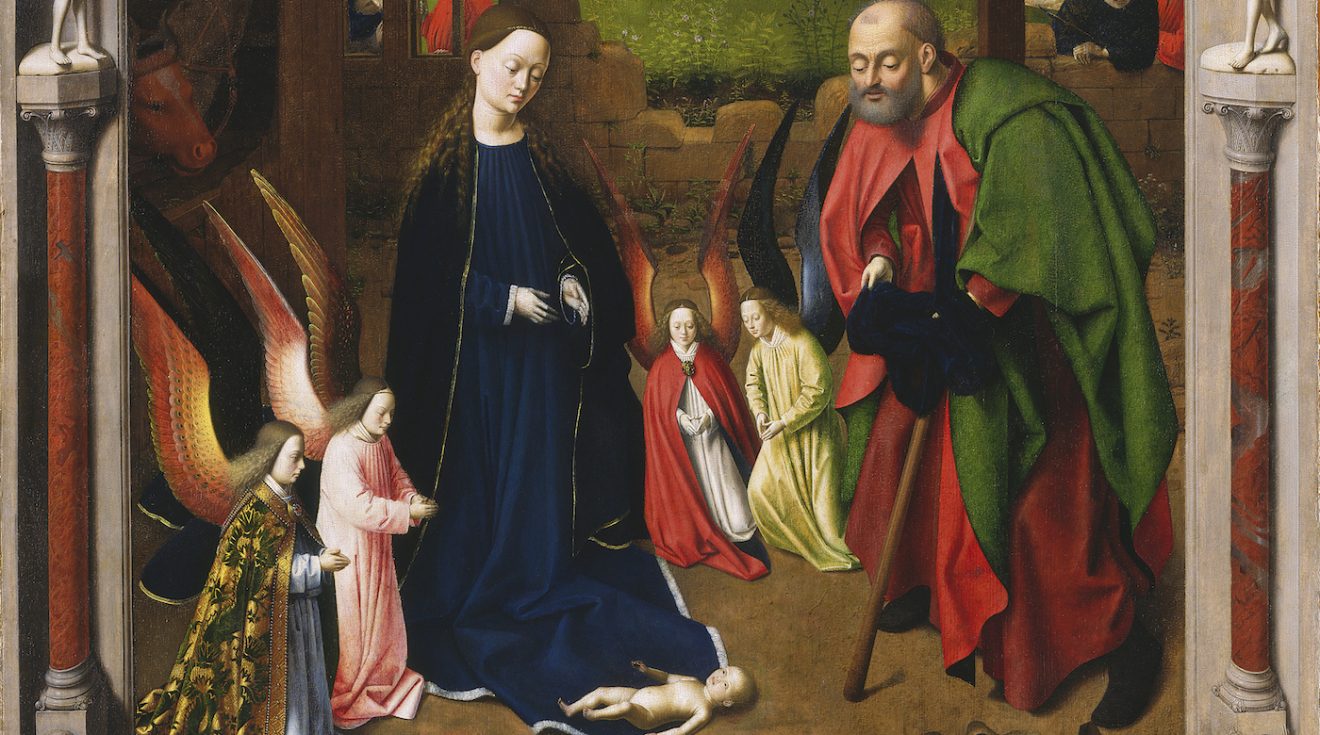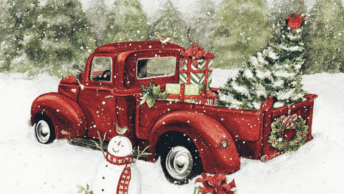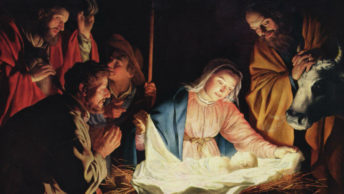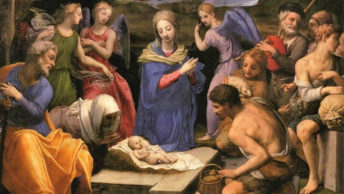During the Christmas season, many of us turn to artworks as objects of contemplation. With Christmas becoming more and more of a commercial holiday, it is important to be reminded of why we are celebrating Christmas. And while the actual date of Christ’s birth is unknown, it is still worthwhile to familiarize oneself with the Christmas miracle.
Learning more about the historical and cultural origins of Christmas is particularly enticing when we consider the time around the 1450s. Despite the absence of the printing press, people knew a lot more about the Bible than we know today and often times were able to grasp the most complex Biblical references in art works.
I would like to encourage the readers of Catholic Journal to spend some time with Petrus Christus’s (1) beautiful Washington Nativity (c. 1450-1460; Bruges). The work features one of the most interesting, unusual and enchanting depictions of the birth of Jesus – which was one of the most popular Biblical subjects, at least since the Renaissance. The work is found today in the collection of the National Gallery of Art in Washington, D.C.
Research about the Washington Nativity has revealed a Spanish provenance and it is assumed that the work was commissioned as an altarpiece and was not intended as an artwork for private devotion. (2) There is no evidence of any missing wings that could be attributed to this painting. (3) With a size of 130x97cm, it is one of the larger works by Christus, (4) who was the official city painter of the City of Bruges after the death of Jan van Eyck. (5) To remind ourselves, the painting reflects the birth of Jesus as told in Luke 2:16-20:
So [i.e. the shepherds] they hurried off and found Mary and Joseph, and the baby, who was lying in the manger. When they had seen him, they spread the word concerning what had been told them about this child, and all who heard it were amazed at what the shepherds said to them. But Mary treasured up all these things and pondered them in her heart. The shepherds returned, glorifying and praising God for all the things they had heard and seen, which were just as they had been told.
In the center of this Nativity, Christus portrays Mary and Joseph, who are both absorbed in the serenity of the moment. The shepherds have not yet arrived to witness the Christmas miracle. The infant Jesus rests on Mary’s blue coat; most of his doll-like body is placed on the coat but part of his head appears to be on the ground and not in an area covered by the extensive garment itself. This particular position is highly unusual; in many other Nativity artworks, one can see Jesus lying on the ground itself without any protection, explicitly indicating his humility (for example, Petrus Christus’s “Berlin Nativity” from 1452). The fact that Christus chose this position of “semi-humility” for Jesus might still allude to his humility, but also to the fact that he nonetheless has a prominent position in the world – he is simultaneously both God and human. In addition, it makes his connection to Mary even stronger, as the quintessential blue coat can be understood an extension of Mary (who is portrayed with a halo), connecting her directly with her son. The coat itself, however, can also be considered a sign of humility: it does not have a very elaborate design, but is instead relatively plain, simple, and unpretentious in nature, corroborating the claim of the famous art historian Erwin Panowsky who said that Petrus Christus’s art was “humbly human rather than heroic.” (6)
Joseph, untidily dressed, is leaning forward and the position of his head looks slightly awkward, similar to how the position of the goldsmith’s head in Christus’s well-known St. Eligius in his Studio (c. 1449) looks somewhat odd. Joseph is barefoot, and in front of him one can see his pattens. This depiction of him without shoes on implies the holiness of the ground on which he is standing. The fact that he has taken off his hat and is holding it in his hands enhances the dimension of reverence in the scene. (7) On a metaphorical level, the sandals also ask the viewer to consider and juxtapose this with Moses’ encounter with God at the burning bush in the Old Testament. More specifically, Christus refers to Exodus 3: 1-4:17.
When the Lord saw that he had gone over to look, God called to him from within the bush, “Moses! Moses!” And Moses said, “Here I am.” “Do not come any closer,” God said. “Take off your sandals, for the place where you are standing is holy ground.”
Then he said, “I am the God of your father, the God of Abraham, the God of Isaac and the God of Jacob.” At this, Moses hid his face, because he was afraid to look at God.
Thus, Christus creates an almost explicit connection between the Old and the New Testaments. Just as Moses was looking at God for the first time, so is Joseph looking at God for the first time – in the form of his son, Jesus of Nazareth. Finally, it should be noted that while Joseph does not have a halo, he still holds a prominent position which is indicated by his large size (similar to that of Mary) as well as through the Old Testament Moses reference. His role is more like that of Joseph in Gerard David’s Rest on the Flight to Egypt from c. 1510 (where he is portrayed as a family man who takes care of his family shaking fruit out of a tree), and very much in contrast with Joseph in Campin’s Merode Altarpiece, in which he is depicted as somewhat of a “fool,” or, at the very least, a minor character who does not play any role in the conception and is sitting by himself in his studio.
The event is also attended by four angels that are painted smaller in scale at roughly one third of human size. They have large, very natural-looking bird-like wings and in their liturgical outfits. The angels give the scene a Eucharistic dimension, which is quite appropriate given the painting’s likely use as an altarpiece. Newborn Jesus is at the center of everyone’s view, but other than that, there is nothing else in the composition that would further emphasize this prominent position. For example, there are not any forms of special illumination, such as in Geertgen to Sint Jans’s Nativity at Night (c. 1470). The setting itself is a relatively run-down stable, which already foreshadows Jesus’s treatment in the community which would deteriorate very quickly as well.
The triangular-shaped roof of the shed – which is also divided into three smaller triangles in addition to forming a rhombus that points to the Christ-child’s body on Mary’s coat (8) could possibly suggest the Holy Trinity. An ox on the left enhances the fact that the Nativity occurs in a stable. In the background, behind a small wall in bad condition, there are four men who do not seem to be very attentive about what is happening in the shed. They are in conversation with each other, but not (yet) really looking onto the scene and are seemingly either unaware or uninterested. With this, Christus already alludes to how apathetically and ignorantly Christ will be welcomed in the world.
Dressed in customary Flemish costumes, the four onlookers are viewed against a traditional Flemish landscape that has a certain allure of tranquility to it. (9) In portraying this background landscape, Christus works in a quite detailed manner and was probably inspired by his hometown of Bruges, where he apparently set himself up “as the new Jan van Eyck”. (10) Christus thus puts the Nativity scene into a contemporary context.
Like other paintings of the time – such as Robert Campin’s Salting Madonna of the Firescreen (c.1430) or Rogier van der Weyden’s St. Luke Painting the Virgin (c.1440) – the Washington Nativity also shows how Christus gradually explores deeper space in paintings by being very detail-oriented and even painting two wanderers – potentially shepherds – and several birds in the far background. (11) On closer inspection, however, the two domed buildings in the back (considered by some art historians the Basilica of the Holy Sepulchre) could also indicate that the scene takes place in Jerusalem, the place of Jesus’s Passion and Christ’s ultimate sacrifice. (12) If this is indeed the case, the Nativity would take place with the backdrop of Christ’s Passion foreshadowing his death, similar to other artworks we looked at in class, such Hugo van der Goes’s Nativity with Shepherds (c.1470) in which the infant Jesus is lyiing in a coffin-like box of hay. All in all, the Washington Nativity depicts a very private, quiet and reverent adoration of infant Jesus which, again, is in stark contrast to other Nativity depictions of the time – such as Campin’s Dijon Nativity (c. 1420), among others – which showcase an exuberant, very animated and cheerful celebration of the birth of Christ. In that sense, it is more similar to the middle panel Nativity scene in Hugo van der Goes’s Portinari Altarpiece (c. 1470) in its basic idea of serenity, quietness and unobtrusive adoration.
In more general terms, the scene taking place in the shed is framed through a Gothic (at that time the prevalent architectural style that was almost universally recognized) archway that serves a “gateway” into the main scene, painted in the popular “grisaille” technique. At the bottom of the painting, an architectural element that looks like a pedestal contributes to the impression that the scene is set up in almost a stage-like setting. The Washington Nativity is also not the first time Christus used an arch in his paintings. His Bruges Nativity (c. 1452), for instance, also showcases an arch; however, the arch in the Washington Nativity is far more intricate and elaborate. Potentially, Christus was inspired to incorporate arches in some of his painting by the works of Rogier van der Weyden who also used Gothic architectural elements in some of his paintings like the Miraflores Altarpiece (c. 1442). However, Christus’s arch is different from these two van der Weyden paintings, as his Nativity separates the viewer from the main scene. This adds a completely new dimension to the painting; the arch is painted in such a natural way that the sculptural elements in the arch appear almost as relief sculptures that are reaching out of the painting, thereby drawing the viewer into the actual nativity scene. This level of naturalism has been regarded by some art historians as a milestone in “Flemish realism.” (13) The focal point of the painting – just above and marginally to the right of infant Jesus – draws the viewer even deeper into the scene.
On the left side of the arch, Christus portrays Adam; on the right side, Eve. Both cover themselves to show their embarrassment, indicating that the scene takes place in medias res, after Eve has eaten from the fruit. In addition, their gazes are going in the direction of the infant Jesus lying on the folds of Mary’s coat. Above both Adam and Eve, the arch is decorated by six Old Testament scenes from the Book of Genesis that are symbolic of sins and disobedience. In each of these scenes, God is confronting mankind with his will; mankind, in turn, is unable to understand and recognize God’s will each time. The scenes are organized in the following six archivolt groups: (14)
The expulsion of Adam and Eve from the Garden of Eden. Adam and Eve live the most beautiful life imaginable with God in the Garden of Eden, but the serpent lures them into eating an apple from the tree of knowledge of good and evil, which God explicitly forbade. After eating from the fruit, God expels them from the Garden.
Adam and Eve at work. This scene references Genesis 3:18 after God has expelled Adam and Eve: “Because you have listened to the voice of your wife and have eaten from the tree of which I commanded you, ‘You shall not eat of it,’ cursed is the ground because of you; in pain you shall eat of it all the days of your life; thorns and thistles it shall bring forth for you; and you shall eat the plants of the field.”
Cain and Abel making an offering. In this archivolt scene, God tells Cain that if he does well, he will be accepted by him. And that if he does not, he will fall into sin.
Cain slaying Abel. Cain does not listen to God and instead, kills his brother Abel, thereby forgoing his chance of salvation.
The Lord speaking to Cain. God asks Cain about his brother Abel (“Where Abel thy brother?) and Cain replies: “I know not: Am I my brother’s keeper?” (Genesis 4:9). In return, God goes forth with punishing Cain: “What hast thou done? The voice of thy brother’s blood crieth unto me from the ground. And now [art] thou cursed from the earth, which hath opened her mouth to receive thy brother’s blood from thy hand; When thou tillest the ground, it shall not henceforth yield unto thee her strength; a fugitive and a vagabond shalt thou be in the earth.” (Genesis 4:10-4:12)
Cain leaving for the land of Nod. Christus portrays how Cain sets out for the land of Nod, the land of the unredeemed.
All six scenes are representations of crime and punishment. Christus thus puts the Nativity and the advent very clearly in the context of the fall and redemption. All these sins are carried by two so-called “Atlantes” – nameless, fictitious columns in the shape of a man whose facial expressions indicate extreme effort and pain in their position of bearing the sins of Adam and Eve – as well as the sins of the world. In a sense, the painting shows “cause and effect”: the sins of Adam and Eve represented in the arch are absolved through the birth of Christ who “takes away the sins of the world.”
Lastly, the two warriors in the roundels in the upper left and upper right corners represent what is wrong or sinful with mankind and what makes people sinners – violence, anger, and wrath. Similar warrior figures can also be found in other Northern Renaissance paintings, for instance in Bouts’ Altarpiece of the Virgin (c.1466) which also contains roundels of scenes with warriors. (15) Once again, Christus makes the connection between committing sins and being redeemed by the Savior of the World quite explicit and portrays the relationship of the Old with the New Testament antithetically and typologically.
With the Washington Nativity, Christus was able to create one of the richest and most complex Nativity scenes of his time. He was able to bring numerous stories together; consequently, the complexity of the painting is virtually unmatched by most other Nativity scenes, making it one of the most intricate – if not the most multifaceted – Christus paintings. Similar to the four men in the back looking into the shed, the viewer is looking upon the scene from in front of the picture. Witnessing the miracle of the birth of Christ, the viewer cannot help but see the connection with the scenes presented in the arch and hope not to make the same mistakes others have made in ignoring or rejecting what God calls them to do. The Washington Nativity is hence capable of calling the viewer – and, ultimately, the worshipper considering the intended use of the painting as an altarpiece – to confront his own fall and exhort him to follow God’s call at all times.
Notes:
(1) Petrus Christus (c. 1410-1475/76) was the official city painter of the City of Bruges (today’s Belgium), succeeding the famous Flemish master painter Jan van Eyck.
(2) Dirk de Vos, The Flemish Primitives (Amsterdam, Netherlands: Amesterdam University Press), 103.
(3) Joel Morgan Upton, Petrus Christus: His Place in Fifteenth-Century Flemish Painting (University Park, PA: Pennsylvania State University Press), 89.
(4) Other well-known Christus works depicting biblical subjects such as The Lamentation (c. 1444) or The Annunciation (c.1452) are sized 26x37cm or 85x55cm, respectively.
(5) De Vos, The Flemish Primitives, 103.
(6) Joel Morgan Upton, Petrus Christus, 89.
(7) John Oliver Hand, Early Netherlandish Art (Princeton, NJ: Princeton University Press), 44.
(8) De Vos, The Flemish Primitives, 107.
(9) “The Nativity,” National Gallery of Art, accessed December 3, 2013, http://www.nga.gov/content/ngaweb/Collection/art-object-page.47.html.
(10) De Vos, The Flemish Primitives, 103.
(11) Petrus Christus is known for being interested in exploring depth in the background of his paintings. His Portrait of a Young Lady (c.1465; Bruges), for instance, was revolutionary in the sense that it was one of the first known portraits with a more elaborate background.
(12) Joel Morgan Upton, Petrus Christus, 97.
(13) Upton, Petrus Christus, 92.
(14) Maryan Ainsworth, Petrus Christus: Renaissance Master of Bruges (New York, NY: The Metropolitan Museum of Art), 158.
(15) Ainsworth, Petrus Christus: Renaissance Painter of Bruges, 160.








